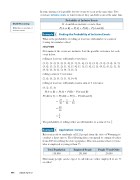Page 459 - Algebra 1
P. 459
In some instances it is possible for two events to occur at the same time. Two events are inclusive events, or joint events, if they can both occur at the same time.
Finding the Probability of Inclusive Events
What is the probability of rolling at least one odd number or a sum of 8 using two number cubes?
SOLUTION
Determine if the events are inclusive. List the possible outcomes for each event below.
rolling at least one odd number outcomes:
(1, 1), (1, 2), (1, 3), (1, 4), (1, 5), (1, 6), (3, 1), (3, 2), (3, 3), (3, 4), (3, 5), (3, 6), (5, 1), (5, 2), (5, 3), (5, 4), (5, 5), (5, 6), (2, 1), (4, 1), (6, 1), (2, 3), (4, 3), (6, 3), (2, 5), (4, 5), (6, 5)
rolling a sum of 8 outcomes:
(2, 6), (6, 2), (3, 5), (5, 3), (4, 4)
rolling at least one odd number and a sum of 8 outcomes:
(3, 5), (5, 3)
P(A or B) = P(A) + P(B) - P(A and B)
Probability of Inclusive Events
If A and B are inclusive events, then P(A or B) = P(A) + P(B) - P(A and B)
Math Reasoning
Write Give an example of inclusive events.
Example
2
P(odd or 8) = P(odd) + P(8) - P(odd and 8) = 27 + 5 - 2
___ 36 36 36
= 30 _
36
= _5 6
The probability of rolling either an odd number or a sum of 8 is _5 . 6
Application: Survey
Briceson needs to randomly call 125 people from the state of Wyoming to conduct a short survey. The following data correspond to estimated values from 2005 describing the state’s populace. Briceson assumes that everyone who is employed is younger than 75.
How many people can he expect to call who are either employed or are 75 or older?
Example
3
Total Population
Employed People
People 75 and Older
510,000
291,000
29,000
444 Saxon Algebra 1


